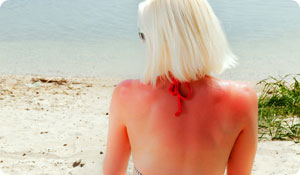
That red, painful-to-the-touch burn on your overly sun-exposed skin can be a big problem—especially if you're an avid beach-goer or a lover of the outdoors. You thought you did everything you could to prevent sunburn, but apparently it wasn't enough. The good news is that it's temporary and treatable.
Adam Friedman, MD, FAAD, a board certified dermatologist at the Montefiore Medical Center, in Bronx, NY, has some insightful tips on how to soothe a sunburn:
1. Use cold water. To minimize the pain, take cool baths or use cold, wet, cloths on the burned area several times a day. Make sure the water isn't too cold—extreme temperatures can affect the skin's ability to control body temperature, and you may end up feeling too hot or too cold.
2. Stay hydrated. Drink 8 to 10 glasses of water to replace fluid loss and to prevent dehydration and dizziness. Also avoid beverages that can exacerbate dehydration such as coffee, carbonated drinks, and alcoholic beverages.
3. Moisturize the affected area. Immediately and frequently, use a cream or ointment such as Lubriderm®, Aquaphor®, Eucerin®, and Vaseline®. Apply the cream when the skin is wet, such as after bathing or when using a cool compress on the sunburn. The cream will serve as a moisture-blocking wall, trapping the water in your skin and helping it heal faster. Some moisturizers, such as CeraVe™ or Cetaphil® Restoraderm®, contain the good fats called ceramides that form as a cement to hold the top layer of the skin, or the stratum corneum, together.
4. Eat antioxidant-rich foods. There are super foods that can help your skin heal and protect it from ongoing damage. Foods rich in antioxidants include blackberries, blueberries, strawberries, plums, artichokes, beans, prunes, and pecans. Free radicals are formed from sun exposure and can damage the membrane of skin cells, ultimately causing damage to DNA. The antioxidants and other phytochemicals in these fruits can protect the cells by quenching the high energy of these unstable radicals, so there is less chance for damage.
5. Do not break blisters if they develop. Blisters can actually serve as a natural bandage for the healing, raw skin underneath. Let blisters open on their own. When they do, use Vaseline® two or three times a day to keep the wound moist. Keep blisters covered with a bandage, and if you're unsure how severe your blisters are or are concerned about infection, check with your healthcare provider.
Signs of infection include increased redness or pain and thick yellow discharge from the blisters. It only takes one blistering sunburn to double your risk of developing melanoma later in life, so if you have a history of one or more blistering sunburns, be sure to have your skin checked regularly by a dermatologist.
6. Stay out of the sun. Sunburned skin is even more susceptible to the harmful effects of ultraviolet radiation, so take extra precautions when going outdoors such as using a broad spectrum sunscreen of at least SPF 30 and wearing sun protective clothing.
7. Use NSAIDs to reduce discomfort and swelling. Take non-steroidal anti-inflammatory drugs (NSAIDs) such as aspirin or ibuprofen two or three times a day to reduce swelling and discomfort. Be sure to take with food and milk to prevent an upset stomach. Don't take NSAIDs if you’ve been diagnosed with asthma, ulcer disease, or a bleeding disorder.
8. Use antihistamines to control the itch and swelling. Antihistamines such as Benadryl® are very helpful, but be mindful that they can cause drowsiness. So don't drive or operate machinery or equipment while taking these types of medicine.
9. Cortisone can provide some relief. Over-the-counter topical steroids or cortisones (hydrocortisone 1 percent) can offer some relief as it is an anti-inflammatory agent. Your dermatologist may prescribe prescription-strength topical steroids or even oral steroids for severe cases. However, there isn't enough evidence suggesting that they truly offer significant help.
A Note About Using Benzocaine
Be cautious of sunburn treatment products that contain anesthetics, such as benzocaine. There's minimal evidence that these products are effective, and in some cases, they can even irritate the skin. Benzocaine has been linked to a rare but serious and sometimes deadly, condition that decreases the amount of oxygen that the blood can carry called methemoglobinemia. Don't use benzocaine in children younger than two years old without supervision from a health care professional, as this age group has been the most affected.





